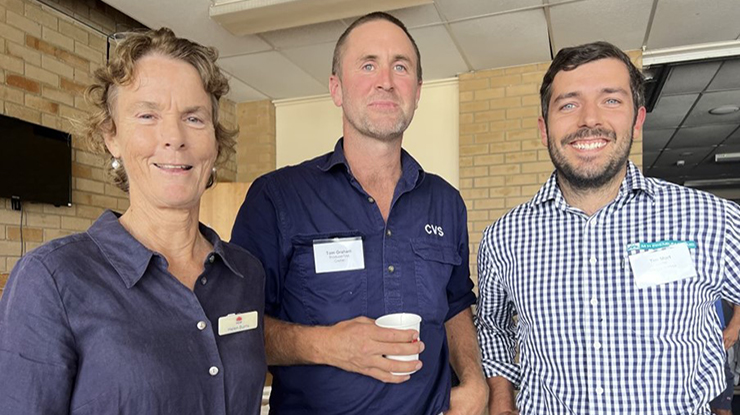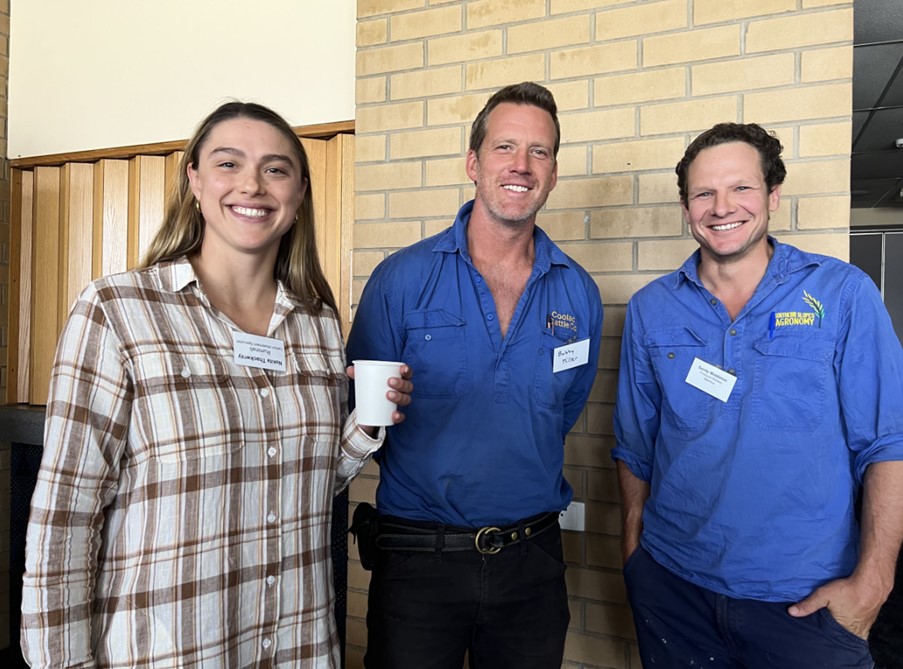 Project lead, Helen Burns (NSW DPI), with Tom Graham (Coolac) and Tim Mort (MH Premium Farms) at the launch of the Pastures for Carbon Neutrality program in Gundagai, NSW.
Project lead, Helen Burns (NSW DPI), with Tom Graham (Coolac) and Tim Mort (MH Premium Farms) at the launch of the Pastures for Carbon Neutrality program in Gundagai, NSW.
Producers and researchers are working together in a ground-breaking MLA Donor Company-funded program to establish how to produce more red meat while emitting less methane.
Through the new Pastures for Carbon Neutrality program, NSW Department of Primary Industries (DPI) and MLA Donor Company have committed to a suite of five-year research projects to investigate complex interactions between soil, plant and animal performance. The program is part of MLA's Emissions Avoidance Partnership and feedbase research and development investments.
Pastures for Carbon Neutrality will work with producers to investigate opportunities to reduce methane emissions from livestock through the most appropriate pasture combinations and management. It focuses on effective management of acidic soils.
NSW DPI Temperate Pastures leader Dr Kathryn Egerton-Warburton said in order to progress towards the industry's goal of carbon neutrality 2030, practice change has to result in the production system being at least as productive as it is today.
"Engagement with producers and industry stakeholders throughout this program will ensure recommendations have a focus on productivity and profitability targets in addressing objectives of reduced methane emissions and improved soil carbon sequestration," she said.


Nakita Thackeray from Ruminati with producers Bobby Miller and Sandy Middleton at the launch of the new program.
Practical outcomes from research
The Pastures for Carbon Neutrality program comprises three areas:
1. Low methane emissions pastures. This area focuses on screening and evaluation of pasture species and mixtures for productivity, persistence, feed value and anti-methanogenic potential.
Outcome for producers: Management guidelines for pasture establishment and grazing for sustainable livestock production with reduced methane emissions.
2. Pastures for acidic soils. This area addresses what for many red meat producers is the first limiting factor to pasture productivity. This activity will extend updated information regarding amelioration of soil acidity and investigate productive pasture mixes (including legumes) to increase animal performance and improve soil carbon.
Outcome for producers: Management guidelines for soil acidity with a focus on pasture productivity.
3. Rapid near-infrared spectroscopy (NIRS) technology. Building on technology developed for assessing feed quality in pastures, researchers will develop a commercially applicable NIRs calibration to enable rapid and affordable prediction of methane production from animal diets. This will facilitate the early stages of selecting low methane producing forages for plant breeding programs.
Outcome for producers: Producers will be able to send feedbase samples for testing of greenhouse gas emissions.
Dr Kathryn Egerton-Warburton said all areas of the program will involve laboratory, field plot and large farm-scale demonstrations, and will measure the impacts of various scenarios and species on soil carbon stocks and soil acidity as well as livestock production and emissions.
"In research, we need to recognise and build on the inter-relationships," she said.
"Once we pull one lever, for example, addressing soil pH limitations – then we need to address the change in paddock composition and the new decisions which need to be made, such as sowing rate, preparation, grazing management. What new options will then be on the table and how do they fit within the production system?"
Underpinning the research design is the need for all outcomes to be easily implemented by producers while retaining or lifting productivity. Check out our related case study on Marcus Richardson for nine strategies producers can start using straightaway to reduce livestock emissions.






